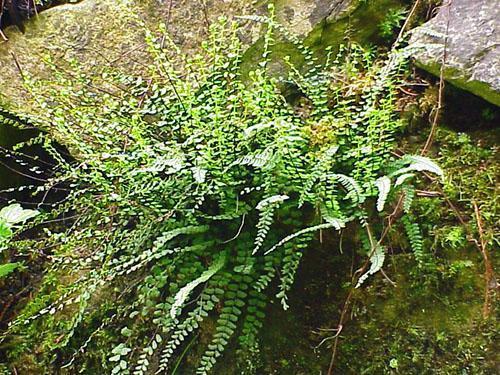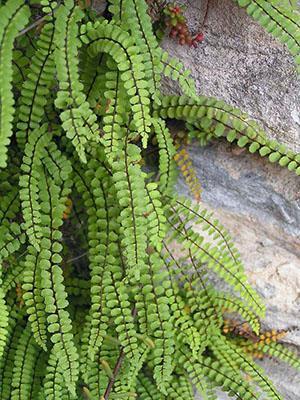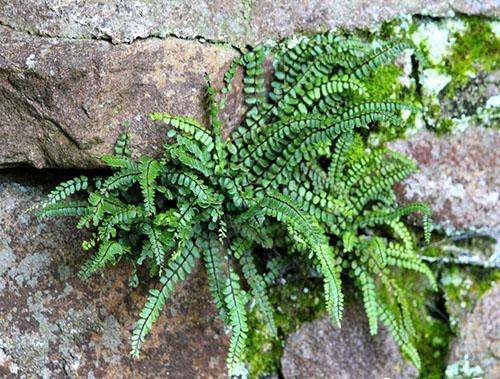What do we know about the natural miracle of Asplenium?

If you look at a globe or a map of the world, it turns out that ferns from the Kostentsov family, practically all continents have lived, except for the forever ice-covered Antarctica. More than seven hundred of these plants of the most ancient origin are settled in Europe, Asia and America. There are Aspleniums in Australia and on numerous islands in the Indian and Pacific Oceans.
But what do we know about Aspleniums, plants whose size can be huge and tiny, the leaves are as flat as a belt, and resemble the feathery foliage of carrots? Even
Aspleniums: characteristics and features of plants

True, in temperate climates, you can find very small herbaceous ferns that prefer to live under trees or even nest on rocky ledges of sandstone or limestone. In the biography of Asplenium there is a "residence permit" on the sea coast of Ireland and a secluded life in the mountains of Dagestan.
It is not uncommon when a fern of the Kostentsov family is found on the wall of a house built of white stone, on an old tower or fortress wall.
 This characteristic of the asplenium gave its name to the whole species. Kostenets wall, or rue muraria, is well known in Europe from the Balkans to Germany. And in Denmark the fern was honored to be imprinted on the Royal china. A special series dedicated to the flora of the country includes more than 700 items, and number 499 includes an elegant plate with a humble asplenium bush.
This characteristic of the asplenium gave its name to the whole species. Kostenets wall, or rue muraria, is well known in Europe from the Balkans to Germany. And in Denmark the fern was honored to be imprinted on the Royal china. A special series dedicated to the flora of the country includes more than 700 items, and number 499 includes an elegant plate with a humble asplenium bush.
 The leaves or fronds of northern fern varieties often have a dissected feathery structure, and the whole leaves, thanks to which the plant received the name "deer tongue", has only a centipede asplenium.
The leaves or fronds of northern fern varieties often have a dissected feathery structure, and the whole leaves, thanks to which the plant received the name "deer tongue", has only a centipede asplenium.
Among the European and American species there are many endemics, ferns found only in a strictly limited region, as well as rare species listed in the Red Book.
 The tropics are inhabited by completely different Aspleniums. The main attention here is attracted by large, if not huge, plants with whole or slightly dissected elongated fronds. Such a fern is hard to miss. Its powerful rosettes in the form of a cup or a funnel reach 1.5–2 meters in diameter. But this is not the only characteristic of Asplenium that attracts the attention of botanists, lovers of tropical flora and tourists to the plant. The plant itself inhabits not only the lower tier of the tropical forest, but also tree trunks.
The tropics are inhabited by completely different Aspleniums. The main attention here is attracted by large, if not huge, plants with whole or slightly dissected elongated fronds. Such a fern is hard to miss. Its powerful rosettes in the form of a cup or a funnel reach 1.5–2 meters in diameter. But this is not the only characteristic of Asplenium that attracts the attention of botanists, lovers of tropical flora and tourists to the plant. The plant itself inhabits not only the lower tier of the tropical forest, but also tree trunks.
 In the process of evolution, such a "woody" way of life forced the plant to form a dense rosette, falling into which plant residues and moisture gradually become food for the fern. The fronds in the lower layers of the rosette, dying off, hang down, and small epiphytes, insects, and even birds settle on them. Asplenium nidus got its name because of its external resemblance to a huge bird's nest. As a result, without harming the tree, the fern independently creates comfortable conditions for itself and many other forest dwellings for a long life.
In the process of evolution, such a "woody" way of life forced the plant to form a dense rosette, falling into which plant residues and moisture gradually become food for the fern. The fronds in the lower layers of the rosette, dying off, hang down, and small epiphytes, insects, and even birds settle on them. Asplenium nidus got its name because of its external resemblance to a huge bird's nest. As a result, without harming the tree, the fern independently creates comfortable conditions for itself and many other forest dwellings for a long life.
 It is interesting that with such characteristics, the nest-like asplenium has become one of the most popular fern species among flower growers. True, hybrids and varieties of more modest sizes than in nature are grown at home. But the foliage of these ferns can be wavy, densely corrugated or finger-like, giving the culture a surprisingly attractive appearance.
It is interesting that with such characteristics, the nest-like asplenium has become one of the most popular fern species among flower growers. True, hybrids and varieties of more modest sizes than in nature are grown at home. But the foliage of these ferns can be wavy, densely corrugated or finger-like, giving the culture a surprisingly attractive appearance.
Reproduction of ferns in nature takes place with the help of spores that ripen on the back of the wai of various shapes. But there are exceptions here, and one of the characteristics of asplenium is live birth, of certain species.
If the majority of ferns, after the maturation of the spores, do not "take care" of their offspring, and the tiny balls carried by the wind settle and take root on their own, then asplenium viviparous and onion-bearing, nicknamed at home hen-laying hen, it is difficult to part with "children". Miniature rosettes from brood buds develop directly on fronds, and only after becoming fully viable, they fall from the mother leaf into loose soil.
Bioenergy of Asplenium plants
 Both in the southern regions, where Asplenium is found, and in European countries, the plant has long been considered useful. At the same time, everywhere the energy of Asplenium has been actively used in folk rituals for many centuries. In Europe to this day, manuscripts have been preserved describing love conspiracies and rituals, where a fern should be a conductor of magical energy.
Both in the southern regions, where Asplenium is found, and in European countries, the plant has long been considered useful. At the same time, everywhere the energy of Asplenium has been actively used in folk rituals for many centuries. In Europe to this day, manuscripts have been preserved describing love conspiracies and rituals, where a fern should be a conductor of magical energy.
Among the peoples of New Zealand, the population of the island territories of the Indian Ocean, the bioenergy of asplenium plants plays an important role in weddings, as well as during childbirth. A plant is used to decorate the road to the house of a young couple, the leaves of the plant are seen off on the last journey of a deceased person.
 It is generally accepted by modern plant energy specialists that asplenium is the green helper of the zodiac sign Pisces. But do not think that only representatives of this sign will feel the beneficial properties of Asplenium.
It is generally accepted by modern plant energy specialists that asplenium is the green helper of the zodiac sign Pisces. But do not think that only representatives of this sign will feel the beneficial properties of Asplenium.
The fern, found in any home, is able to absorb all manifestations of chaos, leveling energy surges and normalizing the emotional background.
In addition, the energy of Asplenium allows you to motivate a person to be creative, improves mood and dispels all doubts regarding mental fruitless throwing and searching for the meaning of existence.
The plant can be safely placed in any living room, because asplenium greens contain no toxic substances, but the fern will help to quickly master new knowledge and increase efficiency.
Useful properties of asplenium
 There are many interesting facts in the biography of Aspleniums. The name of the genus itself can tell about one of them. It recalls that in ancient times the plant was used for medicinal purposes, namely for diseases of the spleen.
There are many interesting facts in the biography of Aspleniums. The name of the genus itself can tell about one of them. It recalls that in ancient times the plant was used for medicinal purposes, namely for diseases of the spleen.
Such use for rhizome and fern leaves was found in ancient Greece. Pliny, for example, believed that asplenium herb could be useful for infertility, and since the Middle Ages, fern has become in demand as a raw material for a medicine for coughs, chest pains and laxatives.
 In Hawaii, asplenium leaf juice mixed with other herbal ingredients was used to treat general weakness and stomatitis in children. According to the beliefs of the peoples of Polynesia, a fern broth can soothe, and also relieve parasitic insects, chest pains. The juice from the fresh leaves removes poison injected by snakes and other animals.
In Hawaii, asplenium leaf juice mixed with other herbal ingredients was used to treat general weakness and stomatitis in children. According to the beliefs of the peoples of Polynesia, a fern broth can soothe, and also relieve parasitic insects, chest pains. The juice from the fresh leaves removes poison injected by snakes and other animals.
For many peoples of the region, the fern is considered a means of contraception. To experience the beneficial properties of asplenium, young leaves are pounded, soaked in water, and the resulting mass is eaten. The plant is also used to relieve contractions in pregnant women and to facilitate the passage of the birth canal for the baby.
 There is another interesting characteristic of Asplenium.In the Marshall Islands, only the unfolding leaves of the nesting asplenium are used for food. Young foliage of viviparous fern is also eaten. If young foliage cannot be found, indigenous peoples use the mature leathery leaves to wrap the fish when baked over a fire or oven.
There is another interesting characteristic of Asplenium.In the Marshall Islands, only the unfolding leaves of the nesting asplenium are used for food. Young foliage of viviparous fern is also eaten. If young foliage cannot be found, indigenous peoples use the mature leathery leaves to wrap the fish when baked over a fire or oven.
 Are the benefits of asplenium confirmed today?
Are the benefits of asplenium confirmed today?
In the course of detailed studies of several representatives of the Aspeniev family, scientists were able to confirm the validity of folk methods of treatment with the help of this species of fern.
Among the positive assessments of the beneficial properties of asplenium, its antibacterial activity, which can be successfully used in the treatment of diseases prostate... The extract obtained from the leaves of the plant also showed antiviral properties, as well as the ability to remove mucus from the body, cleanse the respiratory system and relieve spasms.